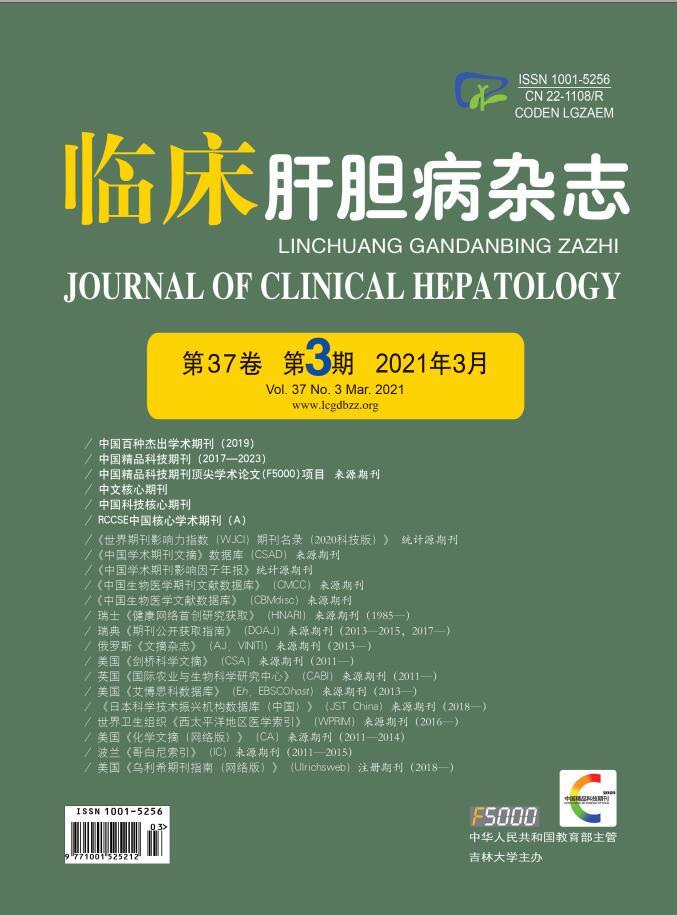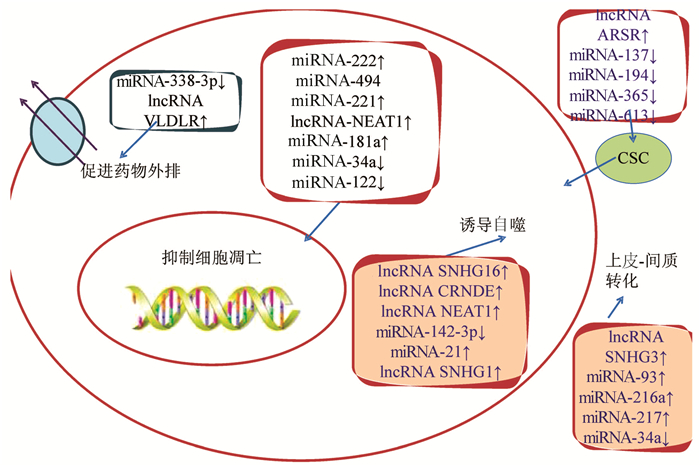| [1] |
HE YJ, ZHANG ZM, HE WM, et al. Epidemiologi-cal characteristics and prognosis of hepatocellular carcinoma: A single - center observational real - world cohort study of 1302 cases[J]. J Clin Hepatol, 2019, 35(5): 1002-1007. DOI: 10.3969/j.issn.1001-5256.2019.05.014 |
| [2] |
DING W, TAN Y, QIAN Y, et al. First-line targ veted therapies of advanced hepatocellular carcinoma: A Bayesian network analysis of randomized controlled trials[J]. PLoS One, 2020, 15(3): e0229492. DOI: 10.1371/journal.pone.0229492 |
| [3] |
AGIRRE E, EYRAS E. Databases and resources for human small non-coding RNAs[J]. Human Genomics, 2011, 5(3): 192-199. DOI: 10.1186/1479-7364-5-3-192 |
| [4] |
KOTAKE Y, TSURUDA T. Long noncoding RNA ANROC on the INK4 locus functions to suppress cell proliferation[J]. Cancer Genomics Proteomics, 2020, 17(4): 425-430. DOI: 10.21873/cgp.20201 |
| [5] |
TSANG WP, KWOK TT. Riboregulator H19 induction of MDR1-associated drug resistance in human hepatocellular carcinoma cells[J]. Oncogene, 2007, 26(33): 4877-4881. DOI: 10.1038/sj.onc.1210266 |
| [6] |
ZHOU JJ, CHENG D, HE XY, et al. Knockdown of long non-coding RNA HOTAIR sensitizes hepatocellular carcinoma cell to cisplatin by suppressing the STAT3/ABCB1 signaling pathway[J]. Oncol Lett, 2017, 14(6): 7986-7992. http://europepmc.org/abstract/MED/29250186 |
| [7] |
SONNTAG R, GASSLER N, BANGEN JM, et al. Pro-apoptotic sorafenib signaling in murine hepatocytes depends on malignancy and is associated with PUMA expression in vitro and in vivo[J]. Cell Death Dis, 2014, 5: e1030. DOI: 10.1038/cddis.2013.557 |
| [8] |
SAMARIN J, LAKETA V, MALZ M, et al. PI3K/AKT/mTOR-dependent stabilization of oncogenic far-upstream element binding proteins in hepatocellular carcinoma cells[J]. Hepatology, 2016, 63(3): 813-826. DOI: 10.1002/hep.28357 |
| [9] |
WANG M, YU F, CHEN X, et al. The underlying mechanisms of Noncoding RNAs in the chemoresistance of hepatocellular carcinoma[J]. Mol Ther Nucleic Acids, 2020, 21: 13-27. DOI: 10.1016/j.omtn.2020.05.011 |
| [10] |
LAI HH, LI CW, HONG CC, et al. TARBP2-mediated destabilization of Nanog overcomes sorafenib resistance in hepatocellular carcinoma[J]. Mol Oncol, 2019, 13(4): 928-945. DOI: 10.1002/1878-0261.12449 |
| [11] |
|
| [12] |
SHIMIZU S, TAKEHARA T, HIKITA H, et al. Inhibition of autophagy potentiates the antitumor effect of the multikinase inhibitor sorafenib in hepatocellular carcinoma[J]. Int J Cancer, 2012, 131(3): 548-557. DOI: 10.1002/ijc.26374 |
| [13] |
CHEN CX, SUN LB, LI T, et al. Study on the molecular mechanism of LncRNA CRNDE up-regulating ATG4B and promoting autophagy of HCC cells[C]// The Chinese Society of Biochemistry and Molecular Biology, proceedings of the national academic conference and the 40th anniversary of the fouding of the society in 2019, 114.
陈岺曦, 孙梁博, 李涛, 等. LncRNA CRNDE上调ATG4B的分子机制及其促HCC细胞自噬的作用研究[C]//中国生物化学与分子生物学会, 中国生物化学与分子生物学会2019年全国学术会议暨学会成立四十周年论文集, 2019: 114.
|
| [14] |
JING Z, YE X, MA X, et al. SNGH16 regulates cell autophagy to promote Sorafenib Resistance through suppressing miRb via sponging EGR1 in hepatocellular carcinoma[J]. Cancer Medicine, 2020, 9(1): 4324-4338.
|
| [15] |
LI X, ZHOU Y, YANG L, et al. LncRNA NEAT1 promotes autophagy via regulating miR-204/ATG3 and enhanced cell resistance to sorafenib in hepatocellular carcinoma[J]. J Cell Physiol, 2020, 235(4): 3402-3413. DOI: 10.1002/jcp.29230 |
| [16] |
ZHANG K, CHEN J, ZHOU H, et al. PU. 1/microRNA-142-3p targets ATG5/ATG16L1 to inactivate autophagy and sensitize hepatocellular carcinoma cells to sorafenib[J]. Cell Death Dis, 2018, 9(3): 312. DOI: 10.1038/s41419-018-0344-0 |
| [17] |
LI W, DONG X, HE C, et al. LncRNA SNHG1 contributes to sorafenib resistance by activating the Akt pathway and is positively regulated by miR-21 in hepatocellular carcinoma cells[J]. J Exp Clin Cancer Res, 2019, 38(1): 183. DOI: 10.1186/s13046-019-1177-0 |
| [18] |
HE C, DONG X, ZHAI B, et al. MiR-21 mediates sorafenib resistance of hepatocellular carcinoma cells by inhibiting autophagy via the PTEN/Akt pathway[J]. Oncotarget, 2015, 6(30): 28867-28881. DOI: 10.18632/oncotarget.4814 |
| [19] |
van ZIJL F, MALL S, MACHAT G, et al. A human model of epithelial to mesenchymal transition to monitor drug efficacy in hepatocellular carcinoma progression[J]. Mol Cancer Ther, 2011, 10(5): 850-860. DOI: 10.1158/1535-7163.MCT-10-0917 |
| [20] |
TAKAHASHI K, YAN IK, KOGURE T, et al. Extracellular vesicle-mediated transfer of long non-coding RNA ROR modulates chemosensitivity in human hepatocellular cancer[J]. FEBS Open Bio, 2014, 4: 458-467. DOI: 10.1016/j.fob.2014.04.007 |
| [21] |
YANG C, CAI WC, DONG ZT, et al. lncARSR promotes liver cancer stem cells expansion via STAT3 pathway[J]. Gene, 2019, 687: 73-81. DOI: 10.1016/j.gene.2018.10.087 |
| [22] |
LU AQ, LV B, QIU F, et al. Upregulation of miR-137 reverses sorafenib resistance and cancer-initiating cell phenotypes by degrading ANT2 in hepatocellular carcinoma[J]. Oncol Rep, 2017, 37(4): 2071-2078. DOI: 10.3892/or.2017.5498 |
| [23] |
RAN RZ, CHEN J, CUI LJ, et al. miR-194 inhibits liver cancer stem cell expansion by regulating RAC1 pathway[J]. Exp Cell Res, 2019, 378(1): 66-75. DOI: 10.1016/j.yexcr.2019.03.007 |
| [24] |
JIANG ZB, MA BQ, LIU SG, et al. miR-365 regulates liver cancer stem cells via RAC1 pathway[J]. Mol Carcinog, 2019, 58(1): 55-65. DOI: 10.1002/mc.22906 |
| [25] |
LI B, LIU D, YANG P, et al. miR-613 inhibits liver cancer stem cell expansion by regulating SOX9 pathway[J]. Gene, 2019, 707: 78-85. DOI: 10.1016/j.gene.2019.05.015 |
| [26] |
ZHANG PF, WANG F, WU J, et al. LncRNA SNHG3 induces EMT and sorafenib resistance by modulating the miR-128/CD151 pathway in hepatocellular carcinoma[J]. J Cell Physiol, 2019, 234(3): 2788-2794. DOI: 10.1002/jcp.27095 |
| [27] |
XIA H, OOI LL, HUI KM. MicroRNA-216a/217-induced epithelial-mesenchymal transition targets PTEN and SMAD7 to promote drug resistance and recurrence of liver cancer[J]. Hepatology, 2013, 58(2): 629-641. DOI: 10.1002/hep.26369 |
| [28] |
JI C, LIU H, YIN Q, et al. miR-93 enhances hepatocellular carcinoma invasion and metastasis by EMT via targeting PDCD4[J]. Biotechnol Lett, 2017, 39(11): 1621-1629. DOI: 10.1007/s10529-017-2403-5 |
| [29] |
JIA H, YANG Q, WANG T, et al. Rhamnetin induces sensitization of hepatocellular carcinoma cells to a small molecular kinase inhibitor or chemotherapeutic agents[J]. Biochim Biophys Acta, 2016, 1860(7): 1417-1430. DOI: 10.1016/j.bbagen.2016.04.007 |
| [30] |
LIU K, LIU S, ZHANG W, et al. miR-222 regulates sorafenib resistance and enhance tumorigenicity in hepatocellular carcinoma[J]. Int J Oncol, 2014, 45(4): 1537-1546. DOI: 10.3892/ijo.2014.2577 |
| [31] |
LIU K, LIU S, ZHANG W, et al. miR-494 promotes cell proliferation, migration and invasion, and increased sorafenib resistance in hepatocellular carcinoma by targeting PTEN[J]. Oncol Rep, 2015, 34(2): 1003-1010. DOI: 10.3892/or.2015.4030 |
| [32] |
FORNARI F, POLLUTRI D, PATRIZI C, et al. In hepatocellular carcinoma miR-221 modulates sorafenib resistance through inhibition of caspase-3-mediated apoptosis[J]. Clin Cancer Res, 2017, 23(14): 3953-3965. DOI: 10.1158/1078-0432.CCR-16-1464 |
| [33] |
CHEN S, XIA X. Long noncoding RNA NEAT1 suppresses sorafenib sensitivity of hepatocellular carcinoma cells via regulating miR-335-c-Met[J]. J Cell Physiol, 2019, 234(9): 14999-15009. DOI: 10.1002/jcp.27567 |
| [34] |
AZUMI J, TSUBOTA T, SAKABE T, et al. miR-181a induces sorafenib resistance of hepatocellular carcinoma cells through downregulation of RASSF1 expression[J]. Cancer Sci, 2016, 107(9): 1256-1262. DOI: 10.1111/cas.13006 |
| [35] |
YANG F, LI Q, GONG Z, et al. MicroRNA-34a targets Bcl-2 and sensitizes human hepatocellular carcinoma cells to Sorafenib treatment[J]. Technol Cancer Res T, 2014, 13(1): 77-86. DOI: 10.7785/tcrt.2012.500364 |
| [36] |
XU Y, HUANG J, MA L, et al. MicroRNA-122 confers sorafenib resistance to hepatocellular carcinoma cells by targeting IGF-1R to regulate RAS/RAF/ERK signaling pathways[J]. Cancer Lett, 2016, 371(2): 171-181. DOI: 10.1016/j.canlet.2015.11.034 |
| [37] |
|
| [38] |
XU K, HE Z, CHEN M, et al. HIF-1α regulates cellular metabolism, and Imatinib resistance by targeting phosphogluconate dehydrogenase in gastrointestinal stromal tumors[J]. Cell Death Dis, 2020, 11(7): 586-590. DOI: 10.1038/s41419-020-02768-4 |
| [39] |
YIN X, LIAO Y, XIONG W, et al. Hypoxia-induced lncRNA ANRIL promotes cisplatin resistance in retinoblastoma cells through regulating ABCG2 expression[J]. Clin Exp Pharmacol Physiol, 2020, 47(6): 1049-1057. DOI: 10.1111/1440-1681.13279 |
| [40] |
SUN Q, ZHANG SY, ZHAO JF, et al. HIF-1α or HOTTIP/CTCF promotes head and neck squamous cell carcinoma progression and drug resistance by targeting HOXA9[J]. Mol Ther Nucleic Acids, 2020, 20: 164-175. DOI: 10.1016/j.omtn.2019.12.045 |
| [41] |
XU H, ZHAO L, FANG Q, et al. MiR-338-3p inhibits hepatocarcinoma cells and sensitizes these cells to sorafenib by targeting hypoxia-induced factor 1α[J]. PLoS One, 2014, 9(12): e115565. DOI: 10.1371/journal.pone.0115565 |
| [42] |
TAKAHASHI K, YAN IK, WOOD J, et al. Involvement of extracellular vesicle long noncoding RNA (linc-VLDLR) in tumor cell responses to chemotherapy[J]. Mol Cancer Res, 2014, 12(10): 1377-1387. DOI: 10.1158/1541-7786.MCR-13-0636 |
| [43] |
KABIR TD, GANDA C, BROWN RM, et al. A microRNA-7/growth arrest specific 6/TYRO3 axis regulates the growth and invasiveness of sorafenib-resistant cells in human hepatocellular carcinoma[J]. Hepatology, 2018, 67(1): 216-231. DOI: 10.1002/hep.29478 |
| [44] |
LI M, SU Y, ZHANG F, et al. A dual-targeting reconstituted high density lipoprotein leveraging the synergy of sorafenib and antimiRNA21 for enhanced hepatocellular carcinoma therapy[J]. Acta Biomater, 2018, 75: 413-426. DOI: 10.1016/j.actbio.2018.05.049 |
| [45] |
ZHAO P, LI M, WANG Y, et al. Enhancing anti-tumor efficiency in hepatocellular carcinoma through the autophagy inhibition by miR-375/sorafenib in lipid-coated calcium carbonate nanoparticles[J]. Acta Biomater, 2018, 72: 248-255. DOI: 10.1016/j.actbio.2018.03.022 |
| [46] |
TANG S, TAN G, JIANG X, et al. An artificial lncRNA targeting multiple miRNAs overcomes sorafenib resistance in hepatocellular carcinoma cells[J]. Oncotarget, 2016, 7(45): 73257-73269. DOI: 10.18632/oncotarget.12304 |
| [47] |
CHEN Y, RAMJIAWAN RR, REIBERGER T, et al. CXCR4 inhibition in tumor microenvironment facilitates anti-programmed death receptor-1 immunotherapy in sorafenib-treated hepatocellular carcinoma in mice[J]. Hepatology, 2015, 61(5): 1591-1602. DOI: 10.1002/hep.27665 |








 DownLoad:
DownLoad: